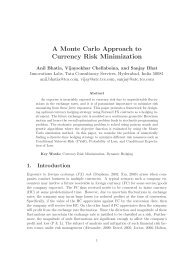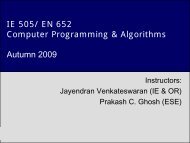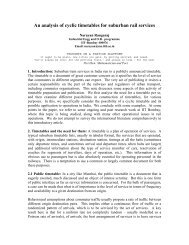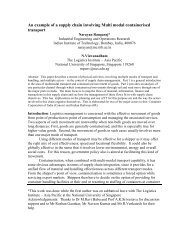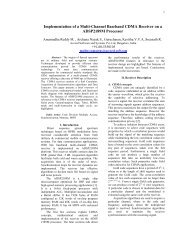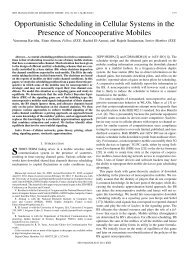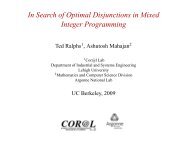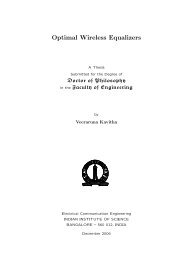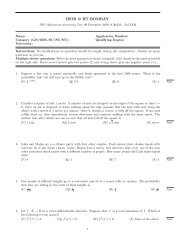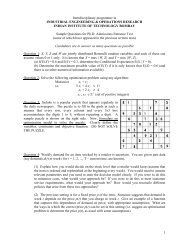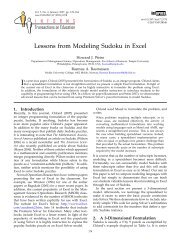Simulation of Multiple Line Rail Sections - IEOR @IIT Bombay ...
Simulation of Multiple Line Rail Sections - IEOR @IIT Bombay ...
Simulation of Multiple Line Rail Sections - IEOR @IIT Bombay ...
Create successful ePaper yourself
Turn your PDF publications into a flip-book with our unique Google optimized e-Paper software.
ISCI 2012 2<br />
1 Introduction<br />
Indian <strong>Rail</strong>ways has a very wide and complex network and variety <strong>of</strong> routes across India.<br />
Across various regions, across various sections the Indian <strong>Rail</strong>ways comprise <strong>of</strong> single<br />
lines, double lines or more than two lines. In certain suburban networks there are also<br />
six parallel tracks set up. There are various performance measures that can be studied to<br />
analyse the track behaviour on a particular section. One can measure throughput (number<br />
<strong>of</strong> trains traversing the section per unit time), headway, average traversal time, maximum<br />
delay for a train etc. However, the sections comprising <strong>of</strong> three lines is <strong>of</strong> peculiar interest<br />
to this particular study. The three-line section comprises <strong>of</strong> two dedicated railway lines.<br />
one reserved for up direction and other for down direction. The third line can be used<br />
in both the direction. The question we will try to address is how a section controller<br />
can utilize the third line for better performance <strong>of</strong> the section across various performance<br />
measures.<br />
As said above, in three-line sections, the third line can be used in both directions as<br />
opposed to the two main lines which can be used only in one direction each. Further, in<br />
a general section, the third line can be in the middle or one <strong>of</strong> the main lines can be in<br />
the middle. The purpose <strong>of</strong> study is to determine in what direction the third line be used<br />
given the traffic parameters in both the directions and the network configuration for the<br />
section. In particular, we will be analysing the performance <strong>of</strong> a Tiruvallur-Arakkonam<br />
section (abbreviated as TRL-AJJ section) in Southern <strong>Rail</strong>ways.<br />
It is observed that during some intervals <strong>of</strong> time the train traffic is more in one direction<br />
than the other direction and during the other intervals <strong>of</strong> time it is vice versa. Hence,<br />
intuition suggests that the direction <strong>of</strong> the third line should be same as the direction in<br />
which there is more train traffic. We identified some ways as how to use the third line.<br />
We tried to determine the direction in which the third line needs to be used during the<br />
various intervals <strong>of</strong> time so as to reduce the overall delay <strong>of</strong> trains. Scheduling strategies<br />
for effective use <strong>of</strong> the third line were discussed.<br />
We have used simulator developed by IIT <strong>Bombay</strong>. It was initially developed for<br />
IRISET (Indian <strong>Rail</strong>ways Institute <strong>of</strong> Signal Engineering and Telecommunication) that<br />
handles train scheduling on a linear section. The simulator finds out a conflict free, feasible<br />
schedule. The simulator also generates a velocity pr<strong>of</strong>ile for the trains using which we can<br />
determine the location and velocity <strong>of</strong> the train at the given time. It handles two kinds <strong>of</strong><br />
trains. scheduled and freight (unscheduled) trains. The loop allocation and the schedule<br />
<strong>of</strong> the freight train can be obtained given the source and the destination station and the<br />
departure time from the source station. The trains are scheduled as per their priorities<br />
and first come first serve criteria. The express trains have the highest priority while the<br />
freight trains have the lowest priority. The current work also aims to see whether this can<br />
be used for larger parts <strong>of</strong> the rail network, by using a combination <strong>of</strong> global and local<br />
scheduling principles.<br />
2 Literature Review<br />
Rangaraj et. al. (2003) have given the detailed description <strong>of</strong> the simulator that we have<br />
used for our experiments. The input and files are described and the algorithm used for<br />
scheduling is described in detail. Abril et. al. (2007) have discussed some techniques for<br />
railway capacity analysis and a simulation based tool, MOM, to perform the same. The



